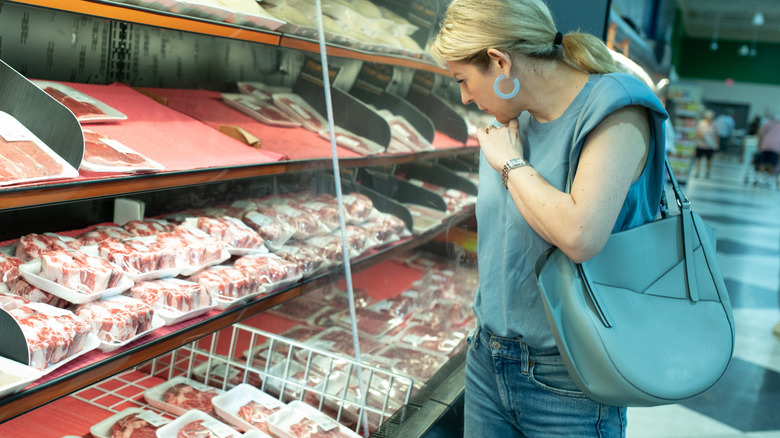Do This To Avoid Getting Salmonella From Beef
At best, food poisoning will make you feel uncomfortable. From shivering to vomiting, you may experience numerous unpleasant symptoms. However, foodborne diseases aren't always merely inconvenient. They can be serious, even life-threatening, which is a reason to take precautions when purchasing, storing, preparing, and preserving foods — including raw beef.
There are many toxins that can give you food poisoning; salmonella is one. Salmonella is a type of bacteria that can be dangerous under the right conditions. Fortunately, the effects of salmonella are usually temporary: After a few days of an elevated temperature and loose stools, you'll probably feel normal again.
But who wants to spend even a few hours dealing with an upset gut and disturbed intestinal tract? That's why you'll want to steer clear of contaminated beef. Remember that uncooked meat is one of the known carriers of salmonella because the salmonella bacteria naturally occurs in some animals, including some livestock creatures.
There's just one issue: Beef that's been contaminated with salmonella doesn't offer obvious clues, so you can't rely on your senses to know if a food has been infected with salmonella. Perhaps that's one reason salmonella is the assumed cause of food poisoning in more than a million cases annually.
Reliable strategies to reduce food poisoning incidents
Here's how to give yourself the best chance of preventing salmonella: Start by addressing the cleanliness of your kitchen. Because salmonella bacteria can live on surfaces from countertops to skin, you should always make sure that you clean your hands and utensils before and after touching raw meat. That way, you will be less likely to transfer bacteria that can start to multiply.
Next, invest in a decent meat thermometer and learn how to tell if meat is likely undercooked. All beef should be cooked to an internal temperature of between 145 and 160 degrees Fahrenheit depending upon the cut. Be fastidious about using your thermometer rather than assuming your beef steak or ground patty is fully cooked. Meat may be sizzling on the outside and barely cooked inside. Additionally, avoid cooking beef in a microwave since it may heat the meat unevenly and leave raw spots.
Finally, put your uneaten cooked beef away as soon as you can. For example, after plating your dinner, put any leftovers in containers and place them into the refrigerator or freezer. That way, the food will cool down faster and be less likely to become carriers of salmonella.
Handling a nasty bout of salmonella
Of course, you can do all you can and still can't always protect yourself from every brush with salmonella, especially if you dine out. While salmonella outbreaks at public places aren't everyday events, they happen frequently enough. A 2023 report on foodborne illnesses from the U.S. Centers for Disease Control and Prevention (CDC) indicates that 18.6% of retail food eatery outbreaks between 2017 and 2019 were traceable to salmonella.
What's the first thing you should do if you think you have food poisoning? Stay hydrated. Food safety professional Dr. Alison O'Brien advises that it's a good idea to drink fluids but "see a doctor if you have blood in your stool" (via the National Institutes of Health). She recommends that children with salmonella poisoning be seen regardless of their foodborne illness severity.
You may also want to call the Meat and Poultry Hotline at 1-888-MPHotline (1-888-674-6854) if you become ill or you want to ask a question about food poisoning. Food and consumer science safety experts can help you navigate your experience and make safer future food choices.


